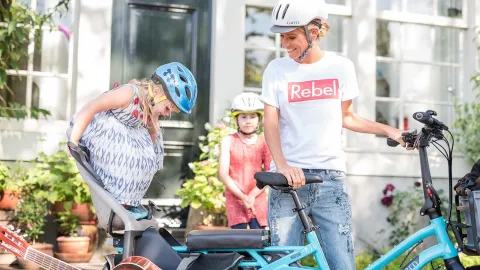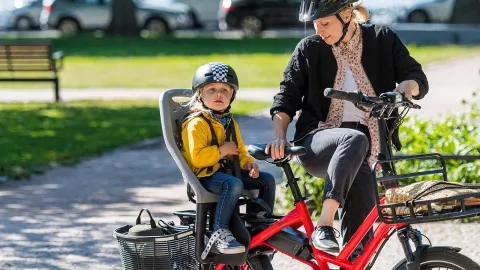
The Orox is a family-friendly adventure e-cargo bike that’s capable of going from paved roads to off the beaten track. While riding on paved roads may be straightforward, the variable nature when you venture on to more rugged terrain means we’ve got some guidelines in place to ensure the safety of you and your passengers. Read on to learn about these guidelines, our recommended passenger accessories for the Orox, how to carry passengers off-road, and more!
Content
- What are the different terrains the Orox is designed for?
- What is the Orox’s load capacity?
- What is the Tern Passenger System?
- What are the recommended passenger setups for the Orox?
- Other useful accessories for carrying passengers
- Some friendly reminders
What are the different terrains the Orox is designed for?
The Orox is a cargo bike that’s designed for adventure. It’s capable of handling all sorts of terrain while under load, as shown below:
Type of Terrain | Paved Roads | Graded & Maintained Gravel Roads | Unimproved Trails |
|---|---|---|---|
| Terrain Description | 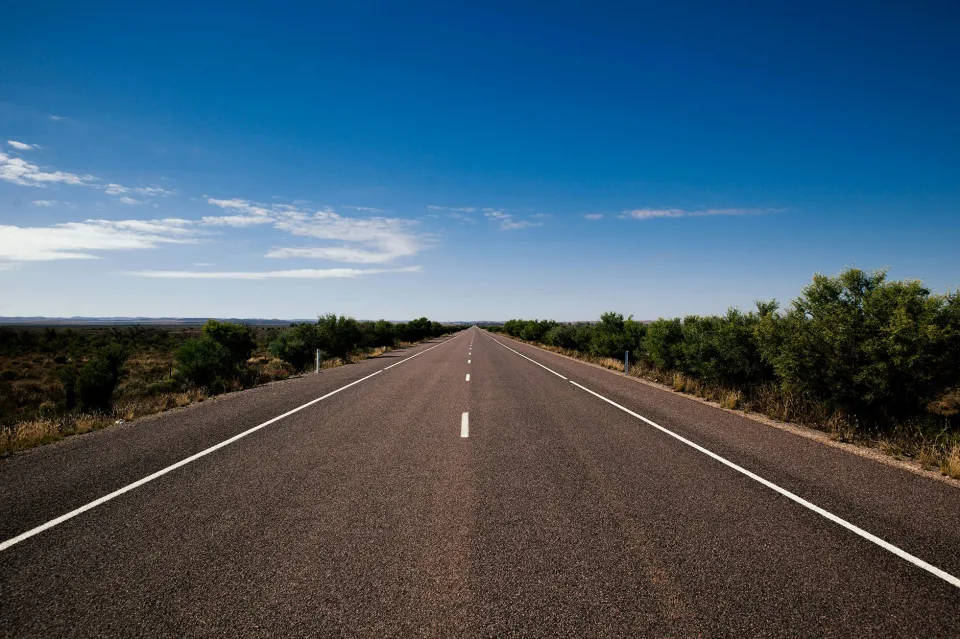
Durable surface material such as concrete or asphalt, laid down on an area intended to sustain vehicular or foot traffic. | 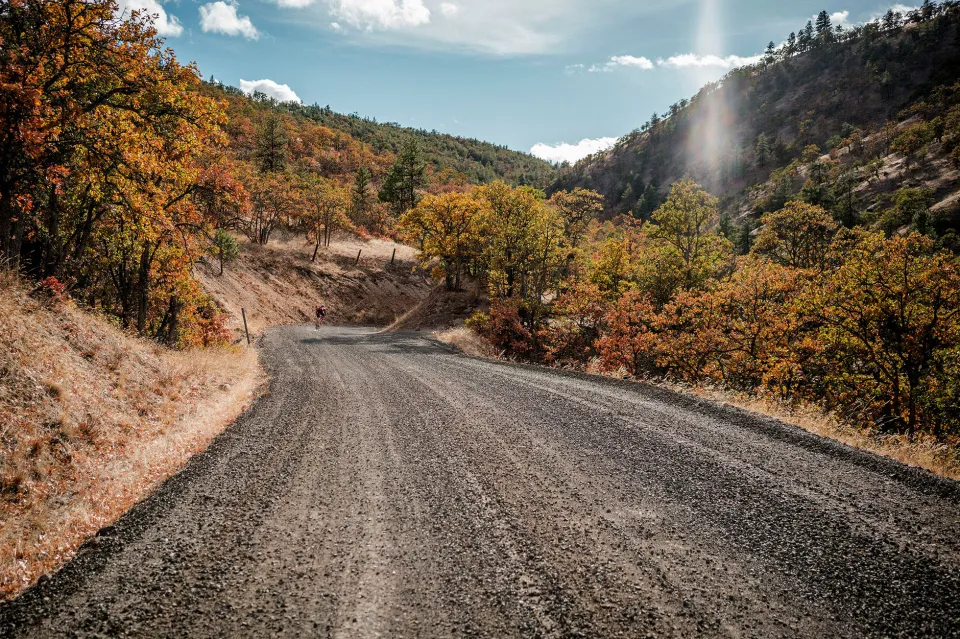
Gravel placed and compacted on finer-grained soil, regularly groomed to remove obstacles. | 
Primitive trails that may contain roots, rocks, loose surface (such as mud), and hardpack. Includes areas where a momentary loss of tire contact with the ground may occur. |
| Passengers Allowed | 2 kids or 1 adult | 1 older kid or 1 adult (≥ 26 kg or 58 lb) | No passengers allowed |
| Max Gross Vehicle Weight* | 210 kg (463 lb) | 210 kg (463 lb) | 180 kg (397 lb) |
*Total weight of Bike (including battery) + Rider + Passenger(s) + Accessories + Cargo + Trailer (without braking system) cannot exceed the Max Gross Vehicle Weight indicated for the terrain type.
If you intend on riding with passengers, it’s imperative to plan ahead and know what type of surface you’ll be riding on, as each of the three terrain types listed above come with different passenger allowance and weight limits for safe riding.
What is the Orox’s load capacity?
Understanding Max Gross Vehicle Weight
To understand the load capacity of the Orox, we start with the maximum weight that a bike has been designed to safely carry. This is referred to as the Maximum Gross Vehicle Weight (MGVW).
The Orox has two sets of MGVW—one for paved roads and graded & maintained gravel roads, and another for unimproved trails.
Orox MGVW | |
Paved Roads | Unimproved Trails |
210 kg / 463 lb | 180 kg / 397 lb |
Paved roads and graded & maintained gravel roads
When riding on paved roads and graded & maintained gravel roads, the Orox has an MGVW of 210 kg (463 lb). This means that the weight of the Bicycle (including the battery) + Accessories + Riders (the cyclist and any passengers) + Cargo + Trailer* must be less than 210 kg (463 lb) for safe riding.

*Trailer = Refers to the weight of the trailer with no braking system AND the weight of any cargo or passenger(s) on the trailer. Trailers with a braking system should NOT be included in the MGVW calculation.
We've tested bicycle trailers for kids from major brands such as Burley and Thule with the Orox on paved roads, but there may be other passenger or pet trailers in the market that are designed for more rugged terrains. Follow the trailer manufacturer's instructions and exercise good judgment on your riding condition for the safety of you and your passenger/pet.
Unimproved trails
The variable and often challenging conditions of off-road riding not only place the bike under greater stress, but also require more effort from the cyclist to maintain control—both of which are further complicated when you add on a load. That’s why the MGVW for the Orox on such terrain is set lower at 180 kg (397 lb). On unimproved trails, the weight of the Bicycle (including the battery) + Accessories + Rider (the cyclist, unaccompanied by passengers) + Cargo + Trailer* must be less than 180 kg (397 lb) for safe riding.

*Trailer = Refers to the weight of the trailer with no braking system AND the weight of any cargo on the trailer. Trailers with a braking system should NOT be included in the MGVW calculation.
Passengers are NOT allowed when riding the Orox on unimproved trails. This includes passengers carried on the bike itself, as well as those in a trailer. However, if you have a cargo trailer that’s designed for operating on such terrains, you may use it for cargo purposes only. Follow the trailer manufacturer’s instructions for your own safety.
Understanding max rear/front cargo weight
Maximum rear cargo weight
The robust Atlas X rear rack of the Orox is rated to carry loads of up to 100 kg (220 lb).

It’s important to make sure the combined weight of your cargo, accessories, and any passenger(s) on the rear rack is under the 100 kg (220 lb) limit.
Maximum front cargo weight
Although the Orox is not designed to carry passengers at the front of the bike, the weight of any front-rack accessories and cargo will count towards the bike’s overall MGVW, so make sure you don’t forget to include this in your calculations. Also, you’ll want to stay within the load limit specified for your front-rack accessories. For example, the Trail Rack is especially designed for riders who’d like to add a front rack to the Orox for carrying additional cargo up front. On paved roads, it can carry loads of up to 25 kg (55 lb).
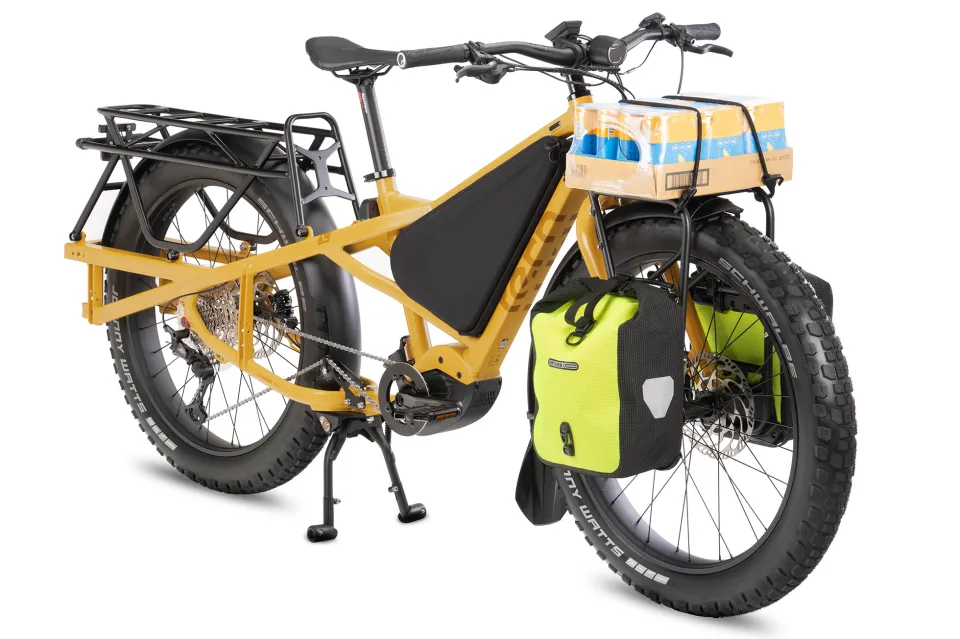
Understanding the cargo weight limits for different terrain types
In addition to respecting the MGVW of your bike for different riding conditions, there are also recommended cargo weight limits set for each condition, as most riders are comfortable carrying a percentage of their body weight.
The cargo weight is the combined weight of your Cargo + Accessories + Any Passenger(s). If you have a trailer with no braking system, its weight as well as the weight of any passenger or cargo onboard the trailer must also be included.
We recommend not exceeding the following cargo weight limits for comfortable handling of the Orox on different terrains:
Cargo Weight Limit | ||
Paved Roads | Graded & Maintained | Unimproved Trails |
70% of the rider’s weight | 50% of the rider’s weight | 20% of the rider’s weight |
How many passengers can I carry?
The passenger allowance on the Orox will differ based on the terrain you ride on:
Passengers Allowed | ||
Paved Roads | Graded & Maintained Gravel Roads | Unimproved Trails |
2 kids or 1 adult | 1 older kid or 1 adult (≥ 26 kg or 58 lb) | No passengers allowed |
A quick summary: guidelines, weight limits, and calculations
We’ve given you a lot of information that may be a tad difficult to remember, so here’s a simple chart with the information you need for calculations:
Riding with Passengers and Cargo | |||
Type of Terrain | Paved Roads | Graded & Maintained Gravel Roads | Unimproved Trails |
Passengers Allowed | 2 kids or 1 adult | 1 older kid or 1 adult (≥ 26 kg or 58 lb) | No passengers allowed |
Cargo Weight* | Should not exceed 70% of rider’s weight | Should not exceed 50% of rider’s weight | Should not exceed 20% of rider’s weight |
MGVW** | 210 kg (463 lb) | 210 kg (463 lb) | 180 kg (397 lb) |
*Cargo weight = Cargo + Accessories + Passenger(s) + Trailer (without braking system) **Total weight of Bike + Rider + Passenger(s) + Accessories + Cargo + Trailer (without braking system) cannot exceed the MGVW indicated for the terrain type | |||
Tip: The weight of your Orox model is printed on the safety sticker on your bike frame, while the weight of all Tern accessories can be found by searching our Accessories page for said accessory and looking under its product specs. The weight of your Bosch PowerPack battery(ies) can be found on Bosch’s e-bike battery page.
What is the Tern Passenger System?
The Tern Passenger System is a framework that includes all our passenger-carrying accessories, and always requires four elements in order to safely carry passengers:
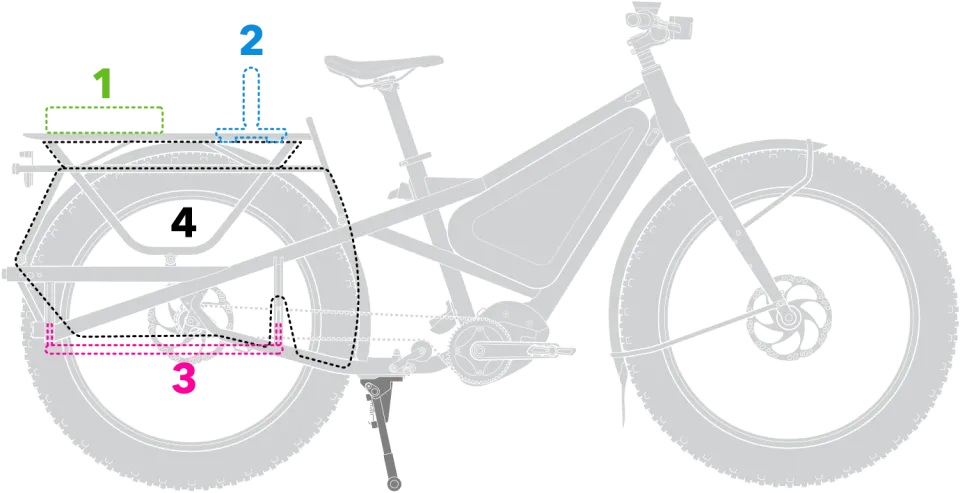
- Seating: Purpose-built rear seating, chosen according to the passenger's needs
- Handhold: Something for the passenger to hold on to, other than the bike itself
- Foot support: Fixed platforms or dedicated foot pegs on both sides of the bike
- Foot and leg protection: Something to prevent feet and legs from getting caught in the spinning wheel
What are the recommended passenger setups for the Orox?
For riding on paved roads
1 young kid
See child seat manufacturer's age and weight recommendations
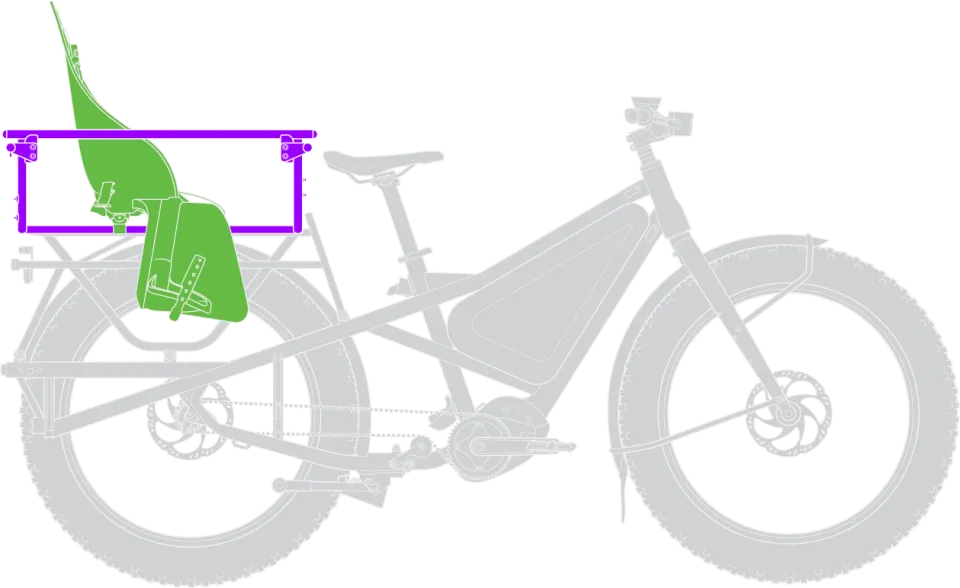
- Seating: 1 compatible child seat
- The Clubhouse Gen 3 can be used with the child seat to provide extra support.
- Child seats should always include the required elements for safe passenger carrying: seating, safety harness, foot support, and foot & leg protection.
2 young kids
See child seat manufacturer's age and weight recommendations
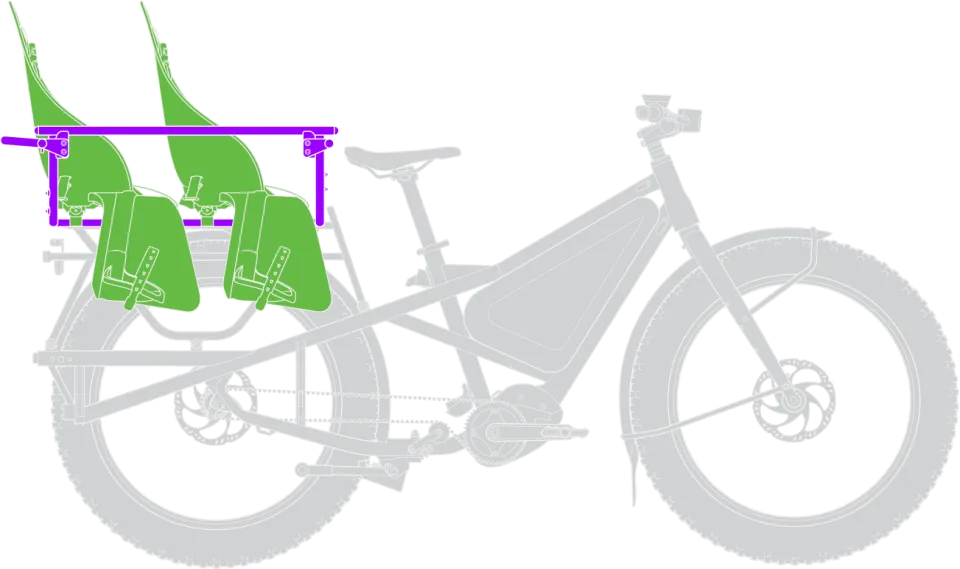
- Seating: 2 compatible child seats
- Seating + Handhold: Clubhouse Gen 3
- Child seats should always include the required elements for safe passenger carrying: seating, safety harness, foot support, and foot & leg protection.
1 young kid + 1 big kid
Young kid: See child seat manufacturer's age and weight recommendations
Big kid: 18+ kg
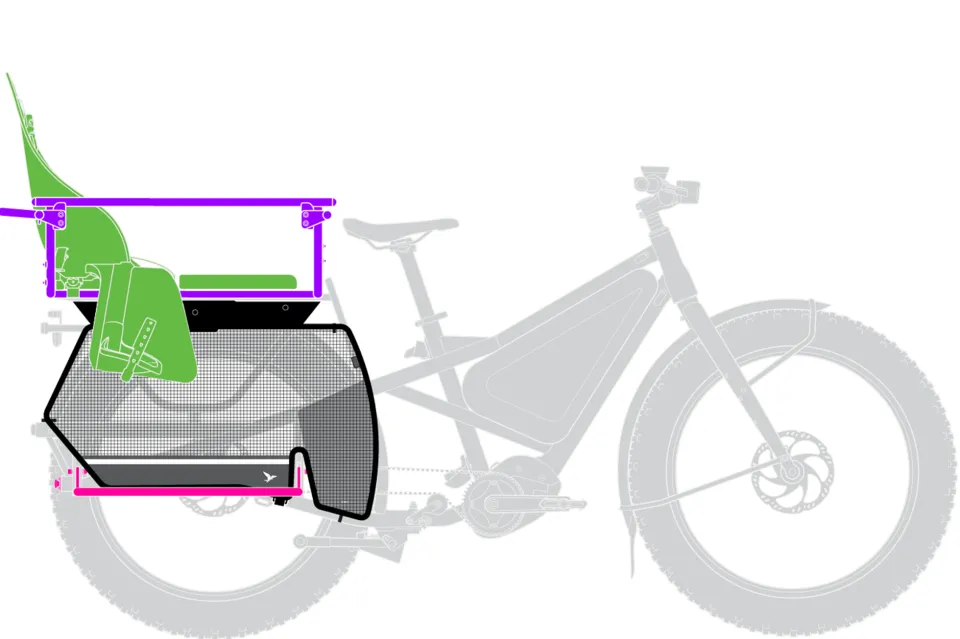
- Seating: 1 compatible child seat (rear)
- Seating + Handhold: Clubhouse Gen 3 and Clubhouse Seat Pad (front) OR compatible Junior Child Seat
- Foot support: Stow Decks
- Foot and leg protection: Sidekick Wheel Guard XL and Guard Panel, OR Cargo Hold 72 Panniers and Guard Panel
1-2 big kids
Big kid: 18+ kg
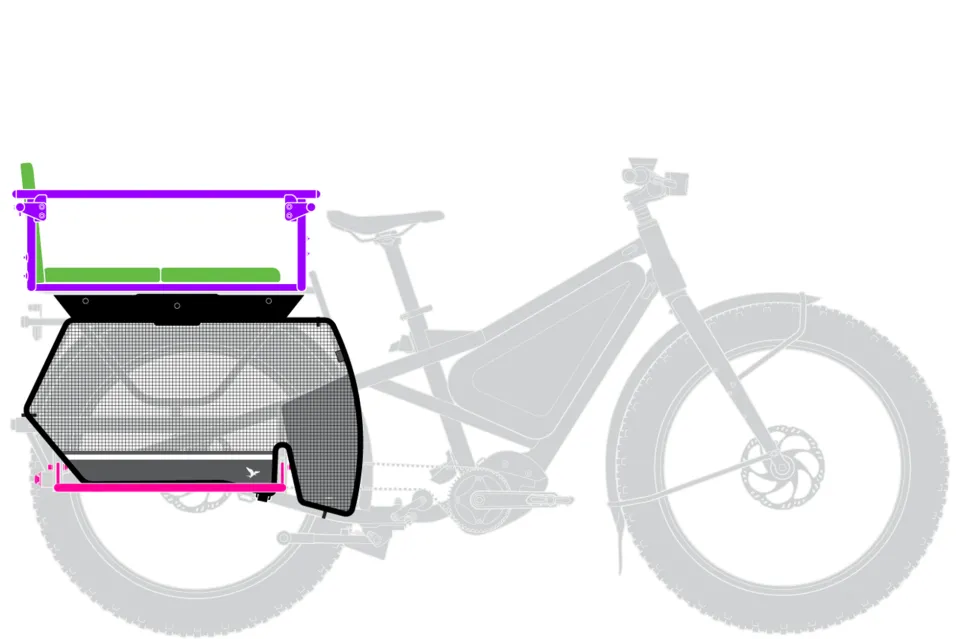
- Seating + Handhold: Clubhouse Gen 3, 2 x Clubhouse Seat Pad, and Clubhouse Backrest
- Foot support: Stow Decks
- Foot and leg protection: Sidekick Wheel Guard XL and Guard Panel, OR Cargo Hold 72 Panniers and Guard Panel
1 older kid or 1 adult
≥ 26 kg or 58 lb

- Seating: Sidekick Seat Pad
- Handhold: Sidekick Handle
OR
- Seating + Handhold: Captain’s Chair
- Foot support: Stow Decks
- Foot and leg protection: Sidekick Wheel Guard XL and Guard Panel, OR Cargo Hold 72 Panniers and Guard Panel
Weather protection for 1 - 2 kids
Young kid: See child seat manufacturer's age and weight recommendations
Big kid: 18+ kg
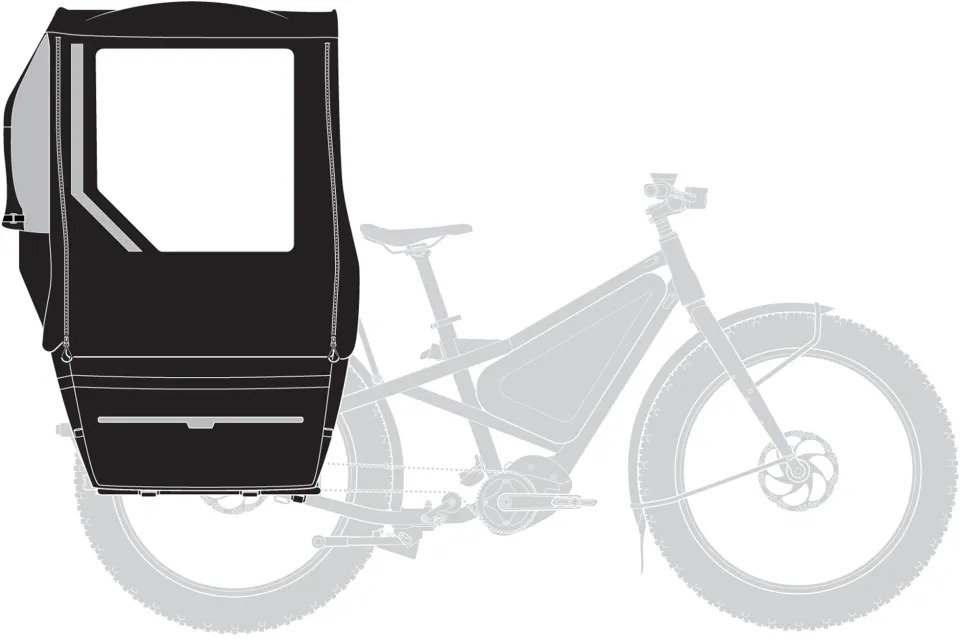
- Seating + Handhold: Clubhouse Gen 3 and any seating setup using compatible child seat(s) and/or Clubhouse Seat Pad / Clubhouse Backrest mentioned above for young & big kids
- Foot support: Stow Decks
- Foot and leg protection: Sidekick Wheel Guard XL and Guard Panel, OR Cargo Hold 72 Panniers with Guard Panel and 4 x Pannier Adapter
- Weather protection: Storm Shield
For riding on graded & maintained gravel roads
1 older kid or 1 adult
≥ 26 kg or 58 lb

Seating + Handhold: Captain’s Chair
OR
- Seating: Sidekick Seat Pad
- Handhold: Sidekick Handle
- Foot support: Stow Decks
- Foot and leg protection: Sidekick Wheel Guard XL and Guard Panel, OR Cargo Hold 72 Panniers and Guard Panel
For riding with pets
For many of us, the dog is part of the family. If your buddy is a small or mid-sized dog up to 13.5 kg (30 lb), we recommend building the Doghouse Mini, for which you need the following accessories:
Other useful accessories for carrying passengers
Orox comes standard with the heavy-duty Atlas Kickstand XL to ensure your bike stays wobble-free when loading and unloading passengers and cargo. But if you’ve got an extra-wriggly kid who you’re not so sure about, we recommend adding Lockstand Extensions to your kickstand.
Lockstand Extensions are designed to give your kickstand an extra-wide footprint for even more stability. As a bonus, they also make the kickstand easier to access—especially when you’ve got fully-loaded panniers.
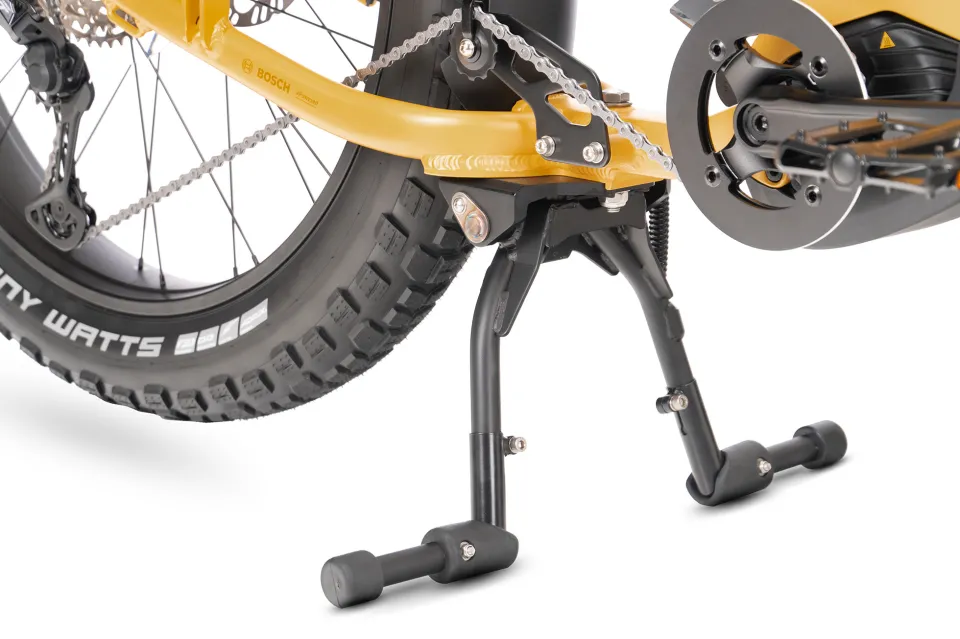
Designed as an add-on for the Clubhouse Gen 3, Clubhouse Mini, and Captain’s Chair, the Sidekick Seat Belt allows kids who have outgrown their child seats to buckle up for the ride with you. Featuring an easy-fastening airplane-style buckle and adjustable strap for the right fit, the Sidekick Seat Belt helps your kids stay cozy in the passenger seat while you focus on the road ahead.
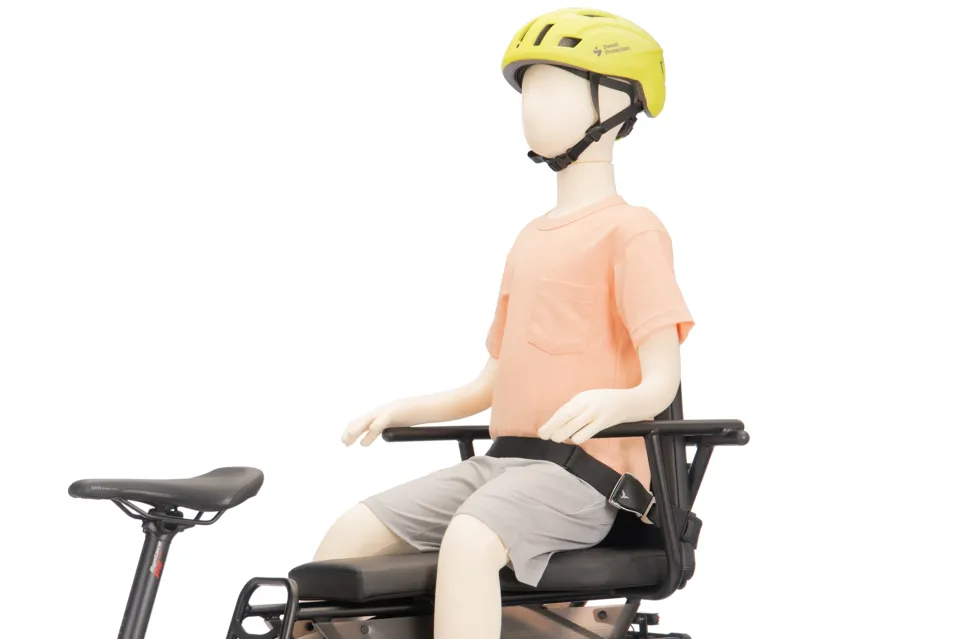
Some friendly reminders
- Please ensure you do not exceed the MGVW and passenger/cargo weight limit specified for the type of terrain you’ll be riding on.
- Get to know how to handle the Orox safely before you add on passengers and cargo. Start slowly on easier terrain and build up your skills.
- When riding with passengers, the Orox must be operated by an adult (18+) who possesses the required experience and physical capacity to operate the bike and control the weight of the passenger safely.
- Check your local regulations to make sure carrying passengers on a bike is legal in your area.
- Helmets are cool! Rider and passengers are advised to wear an approved helmet.
- Do not leave kids unattended on the Orox, even if the double kickstand is deployed.
- Check out our Orox Cargo Guide if you’d like to learn more about carrying cargo.



